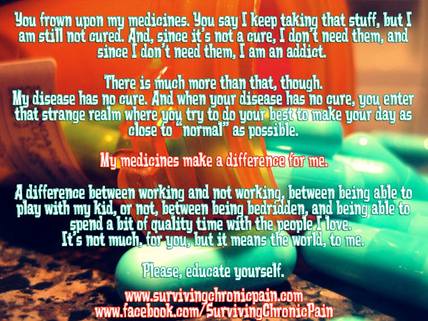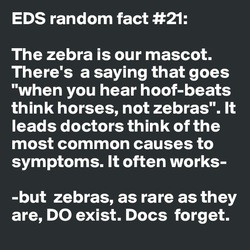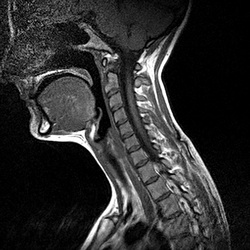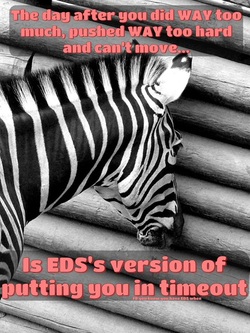
 But of course I'm going to add a bit. There is a huge difference between addiction and dependence. Many individuals (and some physicians) will try to convince you that it is a distinction without a difference, but this is false. Addiction is misuse or abuse of a drug, usually to obtain a high. As an EDS patient, if your pain becomes intolerable and the doctor increases your medication, this DOES NOT make you a drug addict. In fact, most people in pain do not reach any type of high, just pain control. If your EDS were to suddenly disappear you would be tapered off the medication and be drug free again. Much of the same holds true to other medications like steroids and some antidepressants. Pain can cause nausea, anxiety, agitation, depression, feelings of isolation, hopelessness & helplessness. Good pain control can give you quality of life and increase functioning. Pain Control Clinics and knowledgeable physicians can help you obtain the best medication regime for your pain level and lifestyle. You do not have to suffer in pain.
0 Comments
 This article by Marco Castori (keep an eye on him and his group in Italy--they are doing some fantastic work for EDS) is a current and thorough overview of EDS hypermobility type and all of its manifestations.
Abstract: Ehlers-Danlos syndrome, hypermobility type, constituting a phenotypic continuum with or, perhaps, corresponding to the joint hypermobility syndrome (JHS/EDS-HT), is likely the most common, though the least recognized, heritable connective tissue disorder. Known for decades as a hereditary condition with predominant rheumatologic manifestations, it is now emerging as a multisystemic disorder with widespread manifestations. Nevertheless, the practitioners' awareness of this condition is generally poor and most patients await years or, perhaps, decades before reaching the correct diagnosis. Among the various sites of disease manifestations, skin and mucosae represent a neglected organ where the dermatologist can easily spot diagnostic clues, which consistently integrate joint hypermobility and other orthopedic/neurologic manifestations at physical examination. In this paper, actual knowledge on JHS/EDS-HT is summarized in various sections. Particular attention has been posed on overlooked manifestations, including cutaneous, mucosal, and oropharyngeal features, and early diagnosis techniques, as a major point of interest for the practicing dermatologist. Actual research progresses on JH/EDS-HT envisage an unexpected link between heritable dysfunctions of the connective tissue and a wide range of functional somatic syndromes, most of them commonly diagnosed in the office of various specialists, comprising dermatologists. Full article here.  Here is a fantastic EDS handout to take with you EVERYWHERE. It is written by Mark Martino, an EDS patient and longtime member and volunteer at the Ehlers-Danlos National Foundation (EDNF). It is well researched, easy to read, and explains in detail why EDSers may look normal on the outside, yet are literally falling apart at the seams and are prone to chronic, severe pain.
 Are you ever confused why your scans (x-ray, MRI, CT) are read as normal by the radiologist, even though they clearly are not? Maybe you can see your chiari, or CCI, or tethered cord, but somehow the radiologist missed what was right in front of him or her. This article could explain that phenomena.
Results
The results of this study show that 1) chronic pain in EDS is highly prevalent and associated with regular use of analgesics; 2) pain is more prevalent and more severe in the hypermobility type than in the classic type; 3) pain severity is correlated with hypermobility, dislocations, and previous surgery; 4) pain is correlated with low nocturnal sleep quality; and 5) pain contributes to functional impairment in daily life, independent of the level of fatigue. Conclusion From this large cohort of EDS patients, we conclude that pain is common and severe in EDS. Pain is related to hypermobility, dislocations, and previous surgery and associated with moderate to severe impairment in daily functioning. Therefore, treatment of pain should be a prominent aspect of symptomatic management of EDS. Full article here. Interesting article I came across this evening: Joint Hypermobility and Functional bowel disorders
|




 RSS Feed
RSS Feed